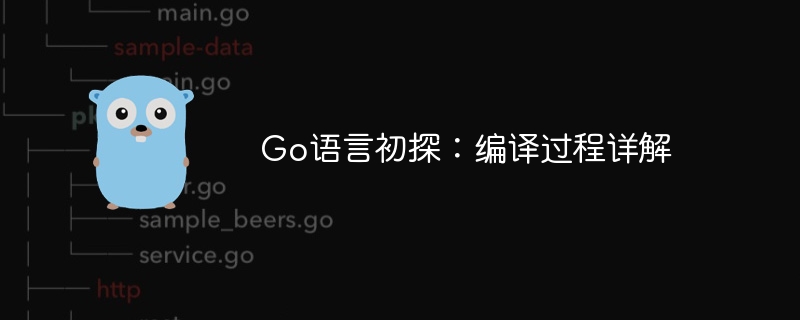

Title: A first look at the Go language: Detailed explanation of the compilation process
The Go language is an open source compiled static language developed by Google to improve programming efficiency and simplify Engineering Management. As a modern programming language, it has excellent concurrency support and efficient garbage collection mechanism, and is also very suitable for building large-scale systems. In the process of learning the Go language, understanding its compilation process is a crucial part. This article will delve into the compilation process of Go language through specific code examples.
The compiler of Go language mainly consists of two parts: front-end and back-end. The front-end is responsible for lexical analysis, syntax analysis and type checking, and generates an abstract syntax tree (AST). The backend is responsible for converting the AST into machine code for the target platform. Now let's look at a simple Go language program and understand the compilation process through code examples.
package main
import "fmt"
func main() {
fmt.Println("Hello, World!")
}The compiler will first perform lexical analysis and syntax analysis, and convert the source code into lexical units and syntax Tree. In this example, the compiler will convert the source code "Hello, World!" into the corresponding lexical units and build a syntax tree to represent the structure of the entire program.
After building the syntax tree, the compiler will perform type checking to ensure that the types used in the program comply with the Go language specifications. For example, whether the type of function parameters and the type of return value match, etc.
Before generating the target code, the compiler will perform a series of code optimizations to improve the performance and efficiency of the program. This includes constant folding, useless code deletion, loop expansion and other optimization methods.
Finally, the compiler converts the optimized code into machine code for the target platform. In the Go language, the compiler compiles the source code into an executable binary file that can be run directly on the target platform.
Now, let us compile and run the above code example through the command line.
hello.go filego build hello.goCompilehello will be generated ./ helloRun the generated executable file and output "Hello, World!"Through the above steps, we successfully compiled and ran the Go language and understood every step of the compilation process. link. Compilation is an important process for a program from source code to executable file. An in-depth understanding of the principles of compilation can help us better understand the working principles of programming languages and improve programming levels and skills.
To summarize, this article introduces the Go language compilation process in detail, from lexical analysis, syntax analysis to type checking, code optimization and target code generation. Through specific code examples and practical operations, I hope readers can have a deeper understanding of the compilation process and master the development skills and methods of the Go language. Let us explore the charm of Go language together and start the programming journey!
The above is the detailed content of A first look at the Go language: Detailed explanation of the compilation process. For more information, please follow other related articles on the PHP Chinese website!
 Usage of Type keyword in Go
Usage of Type keyword in Go
 How to implement linked list in go
How to implement linked list in go
 What are the Go language programming software?
What are the Go language programming software?
 How to learn go language from 0 basics
How to learn go language from 0 basics
 What are the methods to implement operator overloading in Go language?
What are the methods to implement operator overloading in Go language?
 What are the operators in Go language?
What are the operators in Go language?
 Douyin cannot download and save videos
Douyin cannot download and save videos
 Is the speed of php8.0 improved?
Is the speed of php8.0 improved?




